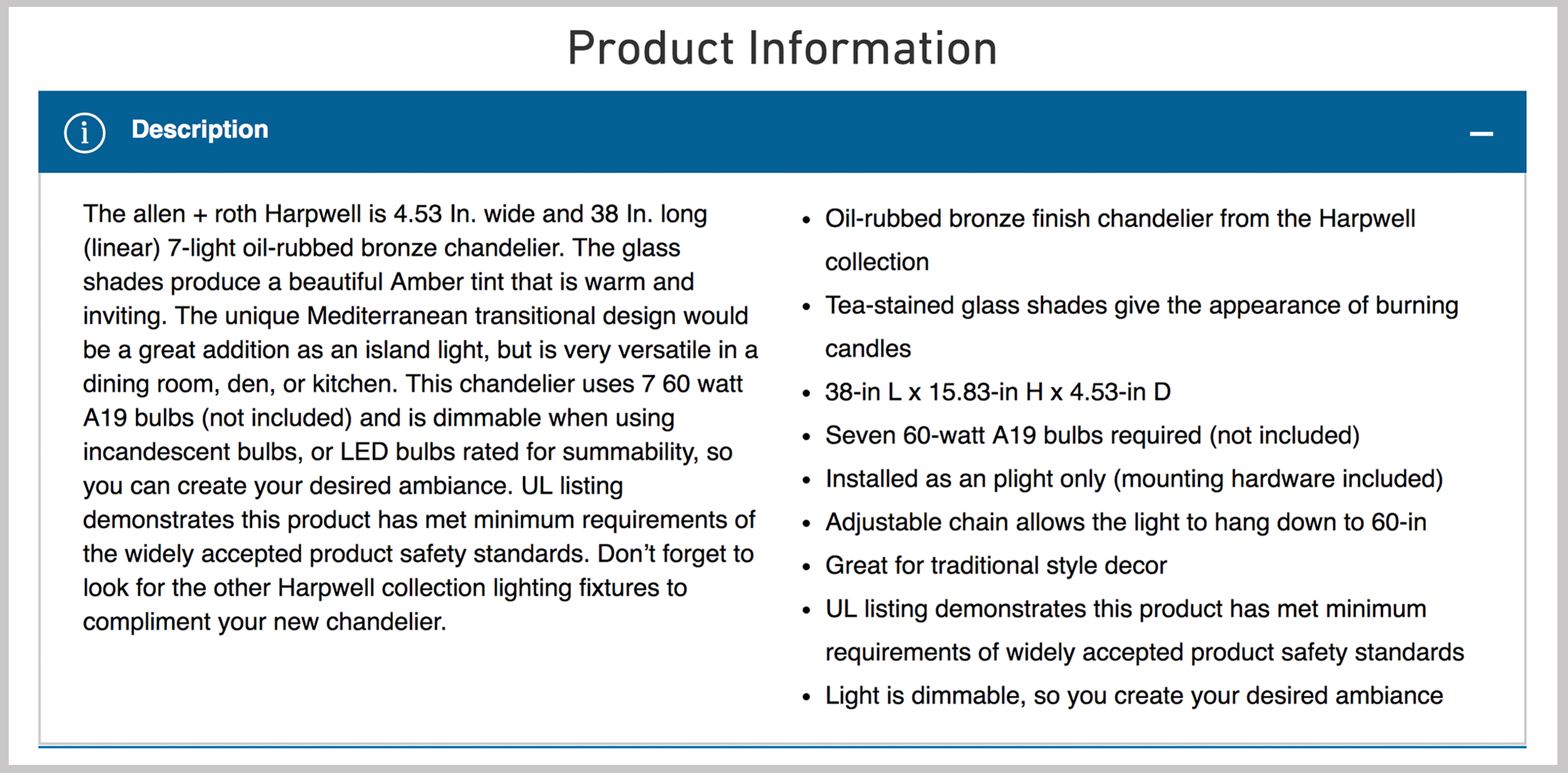
A Tale of Two Chandeliers: How Brands are Failing to Sell Online
As an ecommerce consultant, I’ve conducted several brand reviews over the last year. When I review a brand online, I study how it appears across all e-retailer partners, and time and time again, I notice the same thing.
Many brands are not effectively selling their product in ecommerce.
You may say, “Of course my product is selling! All of them are listed online.”
In reality, there is a big difference between simply placing a product online versus truly selling the product online.
To illustrate the difference between placing and selling, let’s step back and imagine an online shopping trip I call…
A Tale of Two Chandeliers
Picture this: You are re-decorating your dining room and you are window shopping online for a new chandelier. You have a home improvement brand you trust, so you go to their website and start exploring your options.
The following are product descriptions for two similar chandeliers from two different brands.
Chandelier 1


Chandelier 2


Based off of these product descriptions, which chandelier do you think is of the highest quality? Which one is made from the best materials? Which one will be the perfect finishing touch for your new dining room?
My pick is Chandelier #2.
Now step back for a moment and consider that these chandeliers retail for more than $200 each!
Does the copy on Chandelier #1 make you feel like it’s worth every penny? Probably not.
Case in point: simply placing a product online does not mean it will sell
For the first chandelier, the manufacturer simply provided the product specifications, and the e-retailer placed it online for sale. For the second chandelier, the brand provided enticing copy that not only pulls you in, but also helps you envision how the chandelier will fit into your home, and how it will make you feel.
It’s simple: the sell copy of the second chandelier drives higher purchase intent.
Let’s get back to the bigger picture. I believe that most brands are driving awareness through digital advertising tactics. Top brands are finding ways to be more native with their brand’s presentation, and to cut through the clutter online.
But brands are not always selling their products in a compelling way online. Why?
Problem 1: Brands often dedicate more resources to selling on the physical shelf than they do on the online shelf
I find this phenomenon a bit odd. Many brands spend hundreds of thousands of dollars each year designing and testing packaging and advertising. They invest in qualitative testing and eye tracking to understand what elements of a product design will capture the consumer’s attention. Brands rigorously qualify the most impactful claims that will compel you to put their product in your basket, rather than the competitor sitting next to it.
Consider this: the way a product is positioned on an e-commerce product page can drive a purchase to a greater degree than a brand can achieve on shelf.
Problem 2: Brands place products online without focusing on quality sell copy and visuals
Most brands are able to “check the box” on getting the product placed online with a technically accurate description. In many cases, brands are not just leaving the introductory sell copy boring–they aren’t even writing it!
What most brands fail to do is develop, test, and refine proper “sell copy” and create enticing images that introduce the product in the best light possible.
Brands have the opportunity to create an introduction to the product that appeal emotionally to a shopper. Rather than just list the technical specifications, brands have the opportunity to help shoppers understand how the product will provide a benefit better than any other product they are looking at, and also help them feel the satisfaction that will come when they purchase.
What brand directors need to do today to sell online
It is absolutely critical to focus on how your product is appearing on product pages for your top ecommerce partner’s sites. Just as you would dissect package design or advertising copy, you should be doing the same for online product copy and visuals.
If you are not, someone else is winning at the virtual shelf. Remember the Tale of Two Chandeliers!
Key Takeaways
- Many brands spend thousands of dollars on designing and testing packaging, creating advertising, and conducting qualitative testing of product designs. However, brands often spend little to no time on how they present their products online.
- Brands cannot simply place products on e-retailer’s sites. Brands must focus on bringing their product’s benefits to life, and illustrate how the product will meet a shopper’s wants or needs.
- Strong sell copy, illustrative product descriptions, and captivating visuals are essential ways to educate consumers. Help shoppers envision how your product may look or function in use, and how it will make them feel.

Keith Johnson
Keith Johnson is a corporate strategist and innovation expert. Keith spent the first half of his career with Procter & Gamble in the US, Europe, and Asia, with a focus on growing brands through technical and commercial innovation. Most recently with Catalina Marketing, Keith worked to innovate shopper marketing for top consumer product companies through digital promotions and advertising. A serial entrepreneur, he founded and grew a breakthrough ecommerce company and launched a digital marketplace startup. Keith serves as an alumni leader for the University of Chicago Booth School of Business.
Today, Keith is the Founder & Principal of Brilliant Ecom!. Brilliant Ecom! helps brands understand what is happening in their category online, set a solid e-commerce strategy, and provide infrastructure to handle the most critical yet manpower-intensive elements to drive sales.


